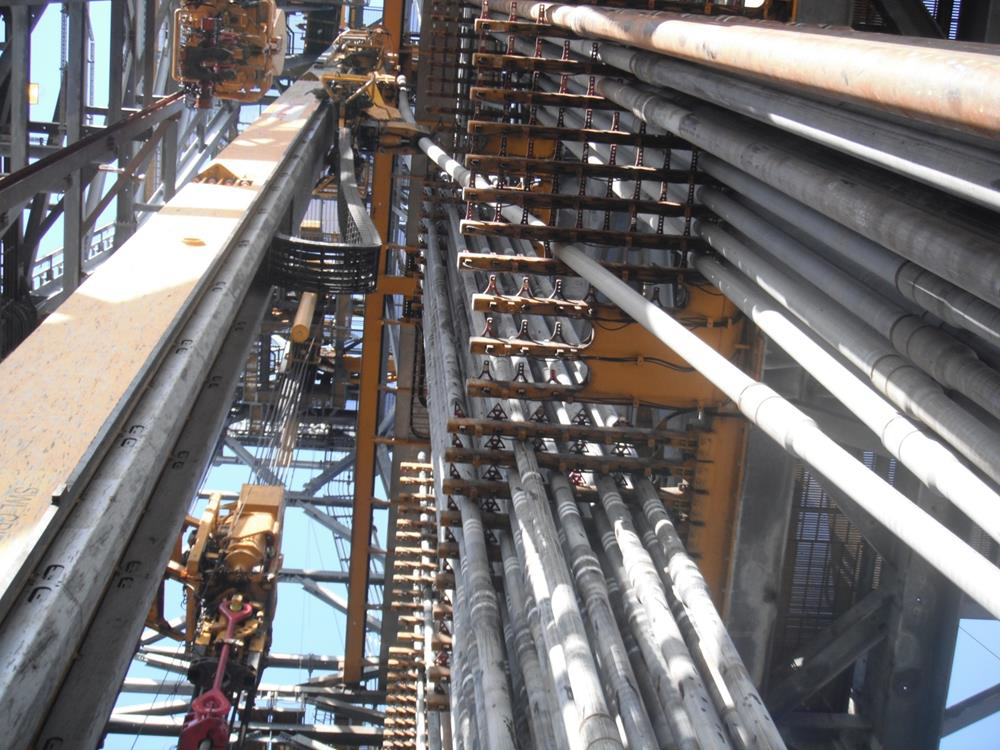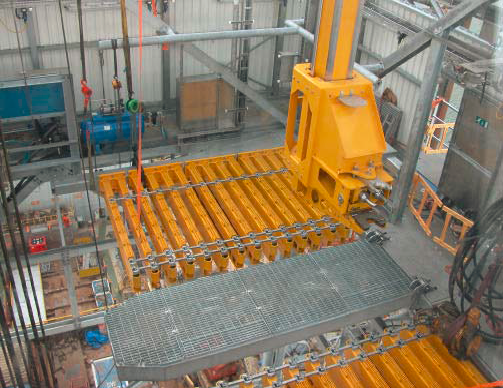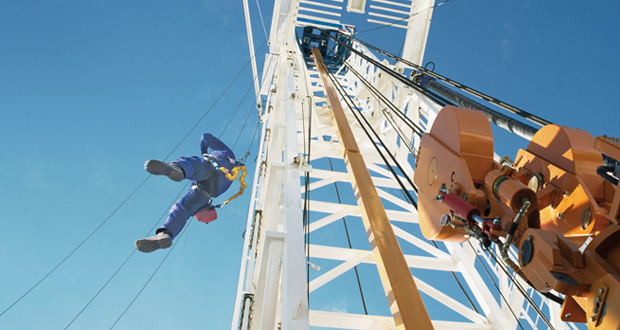Monkey Board Safety Issues
Working on monkey boards entails all the risks of working at heights and working alone. Furthermore, the derrickman must carry out some of the most dangerous operations during drilling. As reported by IADC, in 2018, from 1259 recordable accidents in drilling rigs, about 12 percent involved the derrickman.
This article discusses various monkey board safety issues, as well as precautionary tips from experts. Likewise, some accidents deserve attention.
Table of content
Monkey board
Monkey board is an elevated platform on a mast (rig’s derrick), located at a height equal to two, three, or four lengths of a drill pipe, based on how many lengths of pipe can stand in the rig’s derrick.
Monkey board is generally utilized for handling pipe, sucker rods, or other equipment stored in the derrick tower. It provides a small platform for the derrickman to stand and handle the pipes during tripping in/out when he/she should handle the top end of the pipe, which may be as high as 90 feet (27 m). Using this platform accelerates drilling operations (tripping in/out) since the entire “stands” of a drill pipe can be racked back in the monkey boards.
Monkey board is a lay term used in oilfield. However, the technical term used by various rig manufacturers is different. They call it diving/pipe racking board.
Alex Soares (Drilling HSE Advisor)
This operation is among the hardest physically intensive jobs and can be considered the most dangerous job in every drilling rig. The derrickman must do handling drill pipes at high speed, at a height all alone. During tripping out, he/she must guide the stand of drill pipe into the finger board, and inverse, during tripping in, they have to direct it into the elevator.
The following sections discussed some hazards and recommended safety measures to improve safety on the monkey board.
Monkey board locations and structure
Monkey board structure must be designed and build in a way to avoid any excessive vibrations. It should be safely secured to the derrick with bolts or equivalent fasteners to prevent movement or dislodge during regular operation. The derrickman must check the bolts and fasteners regularly to avoid some loosened bolts lead to an accident. It is also his/her responsibility to secure all objects on the mast.
Derrickman has an obligation to secure all objects that carry to the mast.
Kalongoji Castro (Safety and Risk/ Drilling Co.Man/ Surveyor) LinkedIn
Another vital aspect to consider is the monkey board’s location. It is crucial that the driller always has a clear view of the monkey board, the crown block, and the traveling block at any point of its travel. Furthermore, during tripping-in operations, the driller, the driller’s assistant, or the person responsible for checking whether the latches on the fingerboards are open should stand in the proper position so they can clearly see the drill pipe stands and latches. This place must be determined and reminded to the crew during the pre-job safety meeting.
In 2015, a worker responsible for observing the latches was struck in the head by the bottom end of a drill pipe during tripping operations. One latch in the lower fingerboard didn’t open! The accident happened in the Drillship Pacific Santa Ana (PSA), operating approximately 250 miles south of Lake Charles, Louisiana, in the Gulf of Mexico. The PSA was under contract to Chevron USA. Inc.

In addition, above the decking of each monkey board, there should be a vertical clearance of six and a half feet. Furthermore, the monkey board must be positioned in a way that the running hoisting line never contacts with the platform and the step-in-board must also be folded after latching the drill pipe stand in the elevator.
In one related fatal accident, traveling blocks hit the stepping board while it was being lower into the mouse hole and caused the stepping board to detach from the monkey board and fell from a height of around 27 m onto the rig floor and hit a worker.

Fall protection equipment
Working on monkey boards always needs essential fall protection. OSHA requires separate fall arrest systems to be used with Derrick Belts and Monkey Board Belts. As a rule, this type of safety harness also includes a self-retracting lifeline, energy-absorbing lanyard, or rope grab and lifeline.
The monkey board requires essential fall protection equipment to achieve the 100% tie off at all times.
Bahaa Abdelrahman (National WHS & RTW Coordinator) LinkedIn
The derrickman must also wear fall protection when climbing up from the ladder to reach the monkey board. There are many reasons to be cautious on the ladder, including being greasy, ice-covered, or using very narrow rungs, all of which can cause the derrickhand to slip.
After all, almost all safety professionals who work on oil rigs for several years consider using fall protection equipment one of the most critical safety issues that must be considered. In addition, the derrickman must conduct an inspection to ensure that all fall protection equipment is undamaged. The harnesses and lanyards must also be labeled carefully: available to use or unavailable to prevent accidents due to damaged or worn equipment.
In 2008, a derrickman checking the rear guardrail on the monkey board fell 25 feet (about 8 meters) and was killed. A slip or trip caused him to fall and failing to wear fall protection lead to his death.
It is also worth noting that people sometimes ignore or refuse to wear personal protective equipment. Thus, employers and HSE officers need to come up with innovative ways of encouraging workers to wear essential safety gear. Improving safety culture and accelerating digitalization can be two of the best ways to prevent PPE violations or not wearing fall protection.
Some derrickmans are careless about Body harnesses tie-off, or some forget to do it. It is better if Rig manufacturing companies install some system at monkey board that should be integrated with TDS. So, derrickman needs to tie off his harness since, without tie off, the system sends a signal to TDS to stop the operation until the derrickman hocked up his harness.
Umer Javed CSP (BCSP Mentor | Rising Star NSC | CSP® | ASP® | NEBOSH | IMS⋅CQI⋅IRCA) LinkedIn
Escape Equipment
A monkey board must have an auxiliary escape route. Suppose an employee is unable to escape via the derrick ladder due to a blowout or other emergency in or around the derrick. In that case, an auxiliary means of escape shall be provided to allow them to reach the ground.
This emergency escape line is often called Geronimo Line. The derrickman is required to be attached to the escape device all the time. In an emergency, he can disconnect his safety belt from the rig, firmly grip the tee-bar handle and ride the trolley down the cable while holding on to the handle with his hands.
Escape lines must be equipped with a safety buggy or other approved device. It must also be fitted with a suitable brake and maintained in good condition. Besides, the derrickman should inspect the safety buggy or other approved device at least once a week and record unsafe conditions.
Escape Equipment- Geronimo Line
In the late 70s, Kevin Cooke worked on a rig when the lightning hit the crown block, and derrickman came down through the Geronimo Line as fast as possible.

Others
As well as the monkey board safety issues mentioned previously, many other safety precautions should be taken. The following are a few of them:
Risk assessment
The first step in eliminating hazards and reducing risks is identifying risks and determining what is of most importance. Thus, HSE managers in all workplaces, including oil rigs, must conduct risk assessments prior to implementing any operations. Risk assessments can inform managers about possible hazards and help them find suitable solutions to mitigate the risks.
If I Can add something, as a safety specialist mastering the operational side of the rig will make the difference on a good risk assessment.
Boussad AMALOU (QHSE Manager at Air Drilling Associates) LinkedIn
Housekeeping
Slips, trips, and falls caused by poor housekeeping are other hazards that must be considered. Thus, monkey boards must be kept clean and free of obstacles to mitigate the risk of slips, trips, and falls. It is recommended to cover monkey board surfaces with mats, grates, or cleats to provide good slip resistance.
slippery surfaces increase the risk of slips and falls. The same goes for heavy equipment, objects, and debris that crowd into your workspace.
Viviana Buritica (Profesional SST) LinkedIn
Regular training
People who work on oil rigs need to be well-trained and professional. Even if the company intends to hire a trainee, he/she must be well trained before operating in harsh environments like the monkey board. For example, on the rig floor, there are times when new forces are used to alert the driller when the fingerboard latches are opened. Still, as mentioned previously, this decision may easily result in an accident.
Competency and training of the workforce should be considered.
Yahya Mohamed Mahmoud (Safety manager) LinkedIn
-
Supervision and routine inspection
All equipment on the monkey board must be inspected to ensure that they are undamaged and safe to use, including slip-resistant mats on the surface, guardrails, an escape line, monitoring cameras, and other types of equipment. Furthermore, the monkey board structure, bolts, and joints must also be inspected annually.
All the monkey board structure must be inspected at least every 1 year
Bahaa Abdelrahman (National WHS & RTW Coordinator) LinkedIn
Surveillance cameras
Since the derrickman usually works alone on the platform, the only way the driller or other people can be aware of his/her condition is through the camera. The driller can see the camera’s output in the doghouse.
Lighting
Poor lighting on the monkey board can also result in accidents. As a result, the platform lighting needs to be carefully checked, especially during night operations.
Understanding Monkey Board Accidents: Safety Gaps?
Despite all safety regulations, according to AIDC, in 2020, from 125 reported incidents in Middle East land oil rigs and 165 recordable incidents in US drilling rigs, respectively, about 7 percent and 17 percent happened to derrickmans.
An accident may have resulted from human error. Fatigue, overconfidence, and ignorance are also common reasons.
Therefore safety managers and employers must find new solutions to improve safety on monkey boards. Digitalization and the use of new technologies are some of the solutions, in addition to establishing safety cultures among workers.